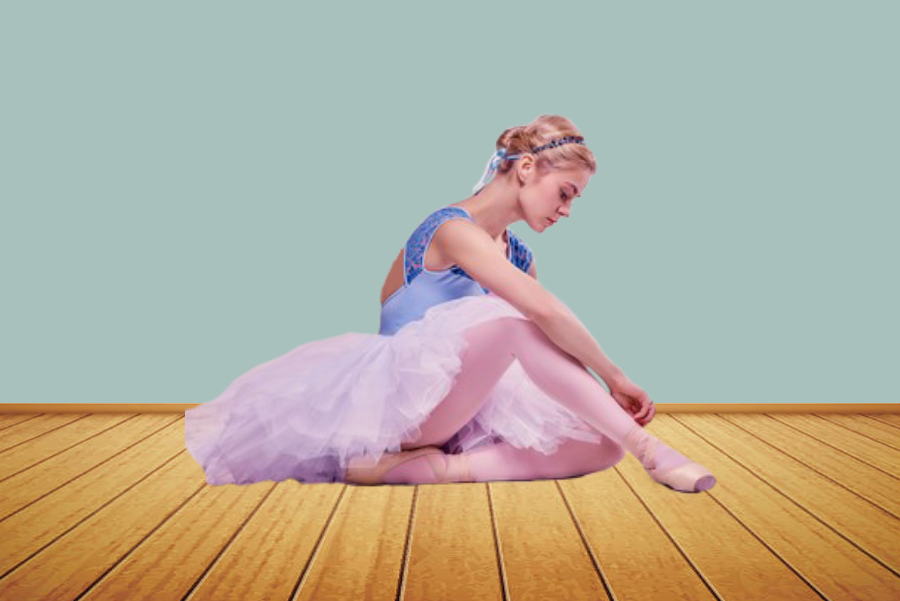Slipping into the toxic culture of ballet
While ballet is no longer a part of my life, I still see a ballerina in the mirror.
April 7, 2022
Content warning: This story contains language that pertains to negative body image and eating disorders.
The reflection in the mirror wasn’t mine. Staring at this altered image of myself, I placed my hands on my rib cage, sucking in my stomach — refusing to let a breath escape. The excitement I might have once felt for my upcoming ballet class had become replaced with dread.
Like many little girls, my dress-up costumes as a child usually included fluffy, pink tutus which I loved plucking out of the costume bin in my home. I twirled around my living room, relishing the freedom of spinning without a care. By the time I turned four, it was an obvious choice for my parents to sign me up for ballet classes at a local studio.
For three years, I took entry-level classes. I learned the basic ballet terms and positions, and I performed in recitals for beaming parents holding camcorders.
By second grade, my skill set advanced to the extent that my beginner education was no longer sufficient. Seeking a more rigorous studio, my mother applied for me to enroll in the Washington School of Ballet (TWSB) in Washington, D.C. Entrance into the prestigious training program required an intense audition.
At the audition, the judges immediately demonstrated that they were going to be no-nonsense, shepherding over 100 young girls into perfectly straight rows across the rubbery floor. I was ecstatic to finally be in a “real” dance studio with wall-to-wall mirrors and shiny wood barres. Out of the 100 girls who auditioned, the school accepted less than half. I was one of them.
Unlike my local ballet studio, TWSB was stern, treating children with similar expectations as the professional dancers at the ballet company. Every year, as I progressed to a higher level, an extra weekly class was added to my schedule. The first half of each class consisted of intense stretching and abdominal exercises; the rest of the instruction time focused on repetitive barre exercises and floor routines. With each leap I pushed my leg’s muscles to the maximum, admiring the 180 degree angle they created in the mirror.
By the age of nine, I mastered the art of wrapping my hair into a sleek, coiled bun, meticulously pinning each strand in place. Messy hair was unacceptable in ballet. So was imperfect posture, yawning, wearing jewelry other than small earrings, standing with your hands on your hips and leaving to use the restroom during class. All I was allowed to do as a young dancer was stand up straight with my hands behind my back and listen.
For the next four years, I quickly changed into my leotard and tights after school most days, eager for class. I was intent on arriving early so I could compete with the other girls to land a prime spot at barre, where the teacher could use you as an example for an exercise and give you corrections. Getting corrections was how you knew the instructor liked you, focused on you and wanted you to improve.
The girls who I competed with — and compared myself to — were the same friends I giggled with before class. The rivalries between us intensified as we got older. The superficial disputes we had at age 10 over who wore the prettiest leotards evolved into bitter, unspoken judgments over who had the smallest waist, who had the highest arches, who caught the teacher’s attention the most and who got accepted into the most rigorous summer intensives.
Despite the growing competition, I couldn’t pull myself away from ballet. I loved the way my chin tilted upward as I elongated my arms above my head in “port de bras” and I loved the way the ribbons of my pointe shoes shone around my ankles. While dancing, I felt beautiful and delicate — exactly what a ballerina is supposed to be.
Around the age of 13, when I started puberty, my childish figure began to develop into that of a woman’s. While many of my peers grew solely upward, their legs and arms looking even thinner than before, my breasts developed, and my height remained in the 50th percentile.
As a new teenager, I was ecstatic to finally look older. But, as I scanned the studio and took in my peers’ lanky figures, I realized that my curves wouldn’t act as an advantage in the world of ballet. Although it didn’t seem like it at the time, in hindsight, my peers faced many of the same struggles that I did. I wasn’t the only one who the teachers told to “suck in your stomach,” or that “your lunch is sticking out of your leotard.” The beautiful friends I had been dancing with for years started to fade away. One of them left completely — her mother pulled her out of classes for anorexia treatment.
In eighth grade, I plunged deeper into the waters of self-hatred. I began having panic attacks before every class, nauseous at the thought of entering the studio that brought me agony. When each class began, I kept my leg warmers and skirt on for as long as possible, hiding every inch of my body.
When I was just in just my leotard and tights, I sucked my stomach, attempting to avoid the critical comments that I knew were about to come from my teachers. My instructors regularly reminded me that I needed to appear effortlessly graceful, no matter how much pain my body was in, and I kept that thought at the front of my mind as my aching feet pirouetted across the floor. I ignored my overworked muscles and blistered toes with a nonchalant, closed-mouth smile on my face. In hindsight, ballet’s ideal concept of perfection — being thin and dainty, with a visible rib cage, long neck and prominent collarbones — was unattainable.
Finally realizing how miserable I had become, I pulled back halfway through eighth grade. I started going to four classes a week rather than five, not worrying about falling behind my peers. I realized that skipping one class each week didn’t matter, and my happiness became my priority rather than performing well in the environment that brought me panic attacks. On my new free day, I took a jazz class. I felt supported in this new setting, and I didn’t face judgment like I did in ballet.
I stopped dancing altogether after I failed to make the poms team during the summer before my freshman year. Feeling disappointed and with no idea how to occupy my time, I tried out for Whitman’s field hockey team after learning that they needed a goalie. I made the team, and to my surprise, I found that skills I had gained from ballet — like flexibility — helped me as I became accustomed to the sport. I loved the new, welcoming environment of field hockey in which teammates cheered each other on rather than turning on one another in vicious competition.
Looking past the toxic environment that consumed my adolescence, ballet taught me critical skills, one being resilience. I don’t dance anymore, but the years of comments about my body have transformed into whispers in my ears that can no longer hurt me. If anything, they’re the “corrections” I now give to myself as I push myself to improve wherever I go.
Ballet also brought me poise. Even three years since I ended my ballet career, strangers still ask me if I’m a dancer. I am constantly told that my posture is impeccable, or that someone can tell I have a background in classical training by the way I walk.
Now, when I see my pairs of pointe shoes hanging by their ribbons inside my closet, I think not of the hardships ballet caused me, but of what I gained from it. Looking at my reflection in the mirror, I still see a dancer, but she’s now confident, no longer chasing the superficial standards set by ballet. When I take a deep breath, I am finally content with letting it go.









Jodi Danis • Apr 18, 2022 at 9:14 am
Beautifully written article! And an important message.